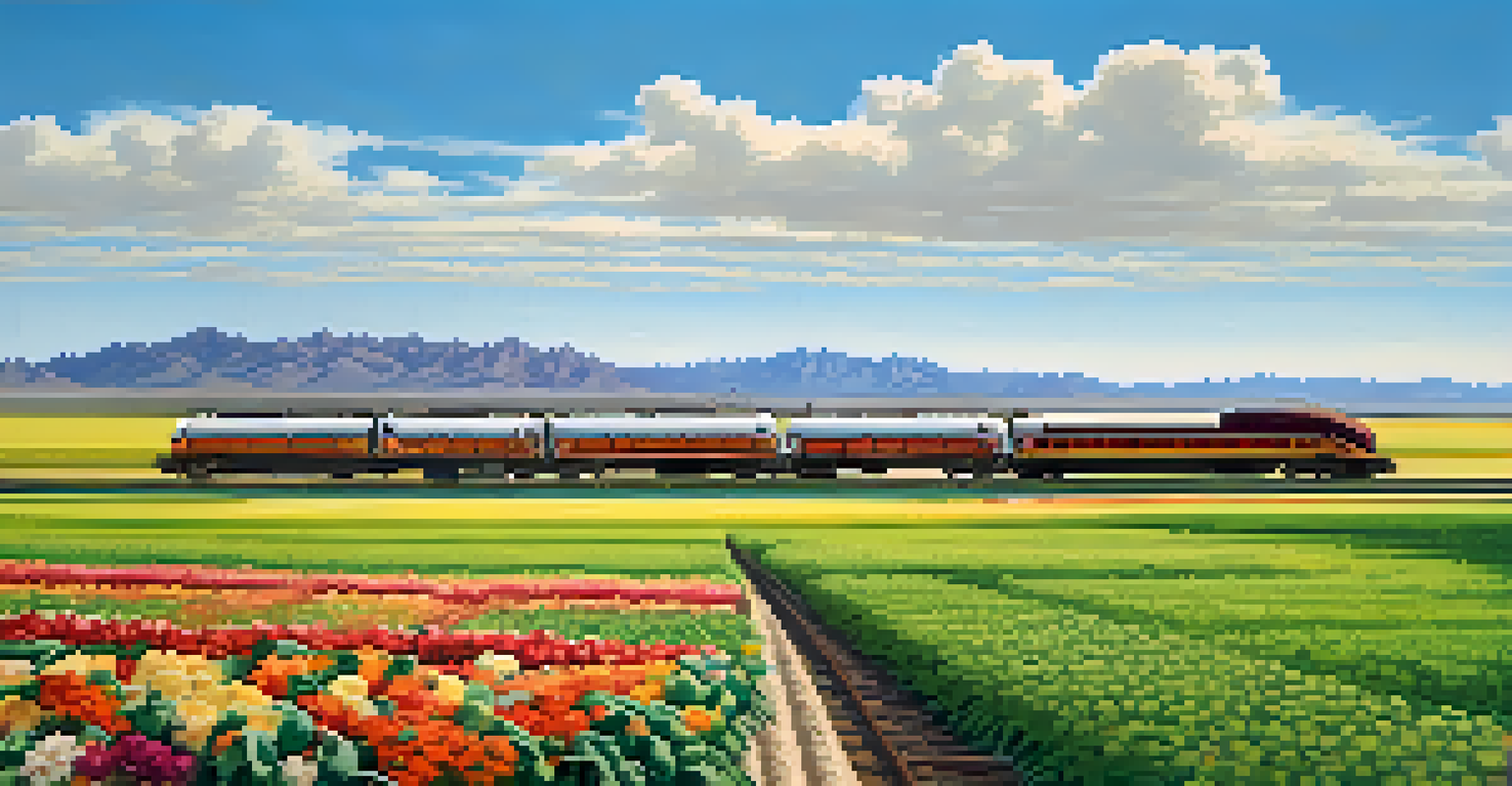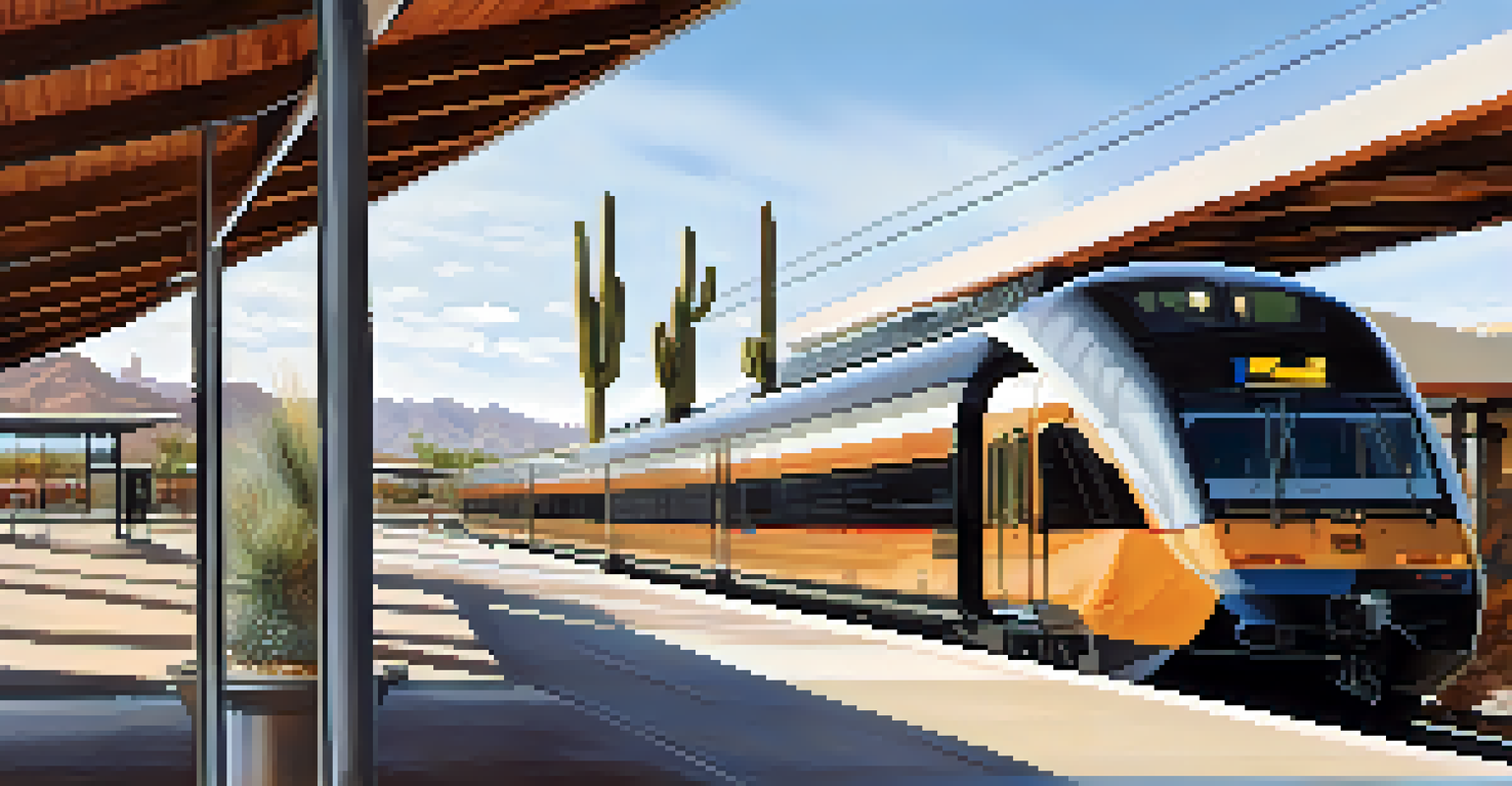The Role of Tucson's Railroads in Trade and Commerce

Historical Overview of Tucson's Railroads
Tucson's railroads have a rich history that dates back to the late 19th century. The arrival of the Southern Pacific Railroad in 1880 marked a pivotal moment, connecting Tucson to larger markets. This network expanded the city's reach, allowing local goods to travel far and wide, thus establishing Tucson as a trading hub.
The railway is a symbol of progress and a means of connecting communities and economies, enabling growth and development.
Over the years, additional rail lines were developed, further enhancing the city's connectivity. The growth of railroads not only facilitated trade but also attracted businesses and industries to set up shop in Tucson. This influx of commerce laid the foundation for the city's economic development.
As railroads evolved, they transformed the landscape of Tucson, leading to population growth and urbanization. The railways became vital arteries of trade, linking the city to both regional and national markets, ultimately shaping Tucson's identity as a key player in the southwest commerce scene.
The Economic Impact of Railroads on Tucson
The economic implications of Tucson's railroads are significant and far-reaching. By providing a direct link to major cities, railroads facilitated the movement of agricultural products, minerals, and manufactured goods. This trade not only boosted local businesses but also created job opportunities for Tucson residents.

Additionally, the railroads played a crucial role in attracting new industries to Tucson. As businesses recognized the advantages of rail access, they began to invest in the area, leading to economic diversification. This shift helped stabilize the local economy and mitigate the effects of agricultural fluctuations.
Railroads Boost Tucson's Economy
Tucson's railroads have significantly enhanced the local economy by facilitating trade and attracting new industries.
Moreover, the economic benefits of railroads extended beyond Tucson. The city's strategic location made it a key transit point, enabling goods to flow between Mexico and the United States. This cross-border trade further solidified Tucson's role in regional commerce, demonstrating the railroads' importance in the broader economic landscape.
Railroads and Tucson's Agricultural Development
Agriculture has always been a cornerstone of Tucson's economy, and railroads played a vital role in its development. With the ability to transport crops efficiently, farmers could access larger markets, increasing their profits. This connection encouraged local agriculture to grow and diversify, contributing to the region's food supply.
Transportation is the backbone of our economy. Without it, commerce would grind to a halt.
The railroads allowed farmers to ship fresh produce to distant cities, thus enhancing Tucson's reputation as a key agricultural producer. Seasonal crops, which could perish quickly, benefited immensely from this transportation method, extending their market reach and shelf life. As a result, Tucson became known for its rich harvests.
Furthermore, the railroads supported the growth of agribusiness and food processing industries in Tucson. By providing a reliable means to transport raw materials and finished products, rail access helped these businesses flourish, creating a more robust agricultural sector that benefited the entire community.
The Role of Railroads in Tourism and Travel
Tucson's railroads have also played a significant role in boosting tourism in the region. In the early 20th century, rail travel became a popular way for visitors to explore the American Southwest. Tucson's scenic landscapes and rich cultural heritage attracted tourists, making it a desirable destination.
As rail lines expanded, they brought in travelers eager to experience Tucson's unique offerings, from its breathtaking deserts to its vibrant arts scene. This influx of tourism provided a substantial economic boost, leading to the growth of hotels, restaurants, and attractions that catered to visitors.
Agriculture Thrives with Rail Access
The efficient transportation provided by railroads has allowed Tucson's farmers to access larger markets, boosting agricultural development.
Moreover, the accessibility provided by railroads encouraged the preservation of Tucson's cultural landmarks and natural wonders. As more tourists flocked to the area, there was a heightened awareness of the need to protect its historical sites and scenic landscapes, ensuring that future generations could enjoy them.
The Influence of Railroads on Local Industries
Tucson's railroads have not only facilitated trade but have also significantly influenced local industries. Key sectors such as mining, manufacturing, and construction benefited from the efficient transportation of goods and materials. This accessibility allowed local businesses to thrive and compete in a broader market.
For instance, the mining industry, which is a staple of Tucson's economy, relied heavily on railroads to transport minerals and ores. The ability to ship these products quickly and reliably was crucial for the industry's growth and sustainability. Consequently, Tucson became known as a center for mining activity in the region.
Additionally, the manufacturing sector in Tucson saw substantial growth due to the railroads. Businesses could source raw materials from distant locations, leading to increased production capabilities. This interconnectivity fostered innovation and economic diversification, making Tucson's economy more resilient.
Challenges Faced by Tucson's Railroads
Despite their many benefits, Tucson's railroads have faced several challenges over the years. Economic fluctuations, competition from other transportation modes, and changing trade patterns have all posed threats to the railway system. These challenges have required adaptation and innovation to maintain relevance in a rapidly evolving market.
In recent decades, the rise of trucking and air freight has shifted the logistics landscape. As companies seek faster and more flexible transportation options, railroads have had to re-evaluate their strategies to attract freight business. This competition has led to a decline in some rail services, impacting the local economy.
Tourism Flourishes via Rail Travel
Railroads have played a crucial role in promoting tourism in Tucson, making it a desirable destination for visitors to explore the region.
Moreover, infrastructure maintenance has become an ongoing concern for Tucson's railroads. Aging tracks and equipment require investment to ensure safety and efficiency. Balancing the need for modernization with budget constraints is a challenge that local rail operators must navigate.
Future Prospects for Tucson's Railroads
Looking ahead, Tucson's railroads have the potential to play a transformative role in the local economy. With a growing emphasis on sustainability, there is renewed interest in rail as an eco-friendly transportation option. Railroads produce lower emissions compared to trucks, making them an attractive choice for businesses aiming to reduce their carbon footprint.
Furthermore, advancements in technology may enhance the efficiency and reliability of rail services. Innovations such as automated systems and improved logistics software can streamline operations, making rail transport more competitive. This modernization could lead to increased freight traffic and stimulate economic growth.

Additionally, there is potential for expanding passenger rail services in Tucson. As urban development continues and more people seek alternative commuting options, enhancing public transportation through rail could help alleviate traffic congestion and promote local tourism. Embracing this future could solidify Tucson's railroads as a cornerstone of commerce and connectivity.